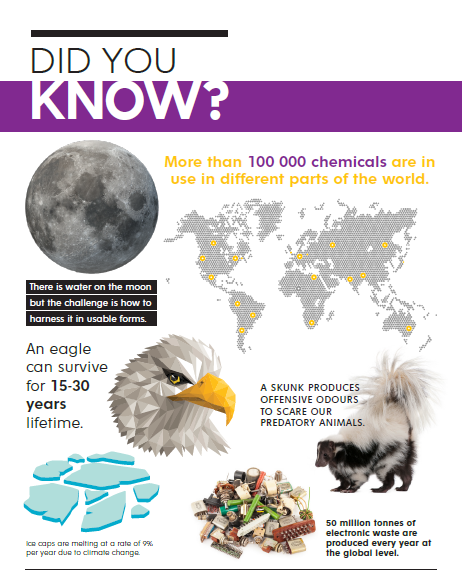Climate change is a phenomenon that can be identified by noting changes in state of climatic properties (by means of statistical tests) that would have taken place over an extended period of time, decades or longer. These changes have been noted to have an effect on invasive alien species proliferation, management and control. The extent to which these two factors are linked is yet to be determined as more studies are being done across the globe. It has been noted that, effects of climate change on invasive species might differ depending on type of species and geographical location, where it can either be positive or negative. In most cases however, climate change has been envisaged to promote growth and invasion of foreign invasive species.
Climatic alterations being felt on different aspects of the environment include changes in temperature, precipitation and frequency of extreme events. These climatic conditions influence species distribution and growth. According to the findings from the United States Global Research Program, these two phenomena are some of the highly considered anthropogenic changes threatening ecosystems today and could have highly devastating effects in the future if not well managed. Invasive species, not only do they invade and affect growth and function of the natural inhabitants in the affected area. They are also threatening agriculture and food security as evidenced by the proliferation of species such as Opuntia Fulgida in the Matebeleland South Province of Zimbabwe.
Approximately 2355 hectares of land has been invaded in Gwanda District taking up land that could be used for livestock rearing and in some instances farming of drought resistant crops. Cases of livestock chocking and death by Opuntia Fulgida have also been recorded. According to the Environmental Management Agency of Zimbabwe, about 1500 households have been severely affected in the districts of Gwanda and Beitbridge alone. This situation can worsen as the effects of climate change come to play unabated.
Invasive alien species are non-native species that are introduced into a foreign environment where it dominates and impairs the structure and function of natural habitats and also displaces and damages native inhabitants. These are regarded as one of the greatest drivers of biodiversity loss as they contribute a huge threat to ecosystem integrity and function. Some of the examples commonly known in Zimbabwe are Prostephanus trancatus (Larger grain borer), Lantana camara, Acacia mearnsii (Black wattle) and Cylindropuntia fulgida (Opuntia fulgida) commonly known as the jumping cholla.
A number of factors have been listed by the Food and Agricultural Organization (FAO) as key contributors that aid the spread of invasive species among which climate change has been mentioned as a key factor. Other factors include economics and trade, tourism, biological control programme and land use changes.
The effect of invasive species can be compounded by climate change and there is a rise in concern on the significance of climate change to invasive species proliferation and control in the world. There are ways that are being put to table for use to try and understand the dynamics of this relationship between the two as there is need for more scientific and practical knowledge on how climate change impacts invasive species patterns and survival. In 2017, translational ecology was formalised. It is a subfield that allows for scientists, natural resources managers as well as decision-makers to work together to develop scientific research which will assist in the management and control of climate change with special reference to invasive species.
Climate change can interact with a number of prevailing stressors that affect the distribution, spread, abundance, impact, management and control of invasive species in what can be termed as the invasion pathway. There are 5 consequences of climate change on invasive species that should never be excluded. These include, playing a part in the transportation and introduction of new invasive species, altering climatic constraints on invasive species, contributing to species distribution of those already existing in an environment, impacting on already existing invasive species and lastly affecting the effectiveness of management strategies.

Climate change will most likely lead to changes in the distributions of species through extreme weather events such as floods, cyclones, hurricanes. Species can be transported across countries and regions allowing them to spread to new areas, providing opportunities for dispersal. As climate change takes its toll, non-resilient native species can be affected and might fail to survive the harsh climatic and environmental conditions. A shift in species range might occur as native species are outcompeted or migrate. This in turn creates ecological space for foreign and newly introduced species to proliferate and become invasive. It is also important to note that invasive species thrive better in disturbed environments and such extreme weather affected environments tend to be ideal for growth and flourishing. Invasive species have short generation times and broad environmental tolerances thus allowing them to cope in harsh environments and adapting to rapid changes.

As predicted in climate change studies, temperature increases will continue to be experienced as the decades go by. This coupled with the continued release of carbon dioxide and nitrogen in the atmosphere provides a highly suitable environment for most invasive species to thrive. Invasive species especially plants favour environments rich in carbon dioxide, nitrogen and enough sunlight for growth. Increase in resource availability has therefore been noted to allow species to invade arid environments. The survival and spread of the Opuntia fulgida in the Zimbabwean Matebeleland South Province, for example. As noted in text, climate change does have an impact on invasive species but to what extend? How will phenomenon such as desertification which can be exacerbated from climate change affect the growth of invasive species such as Opuntia fulgida and what impact will these have on habitants of areas such as Matebeleland South.



